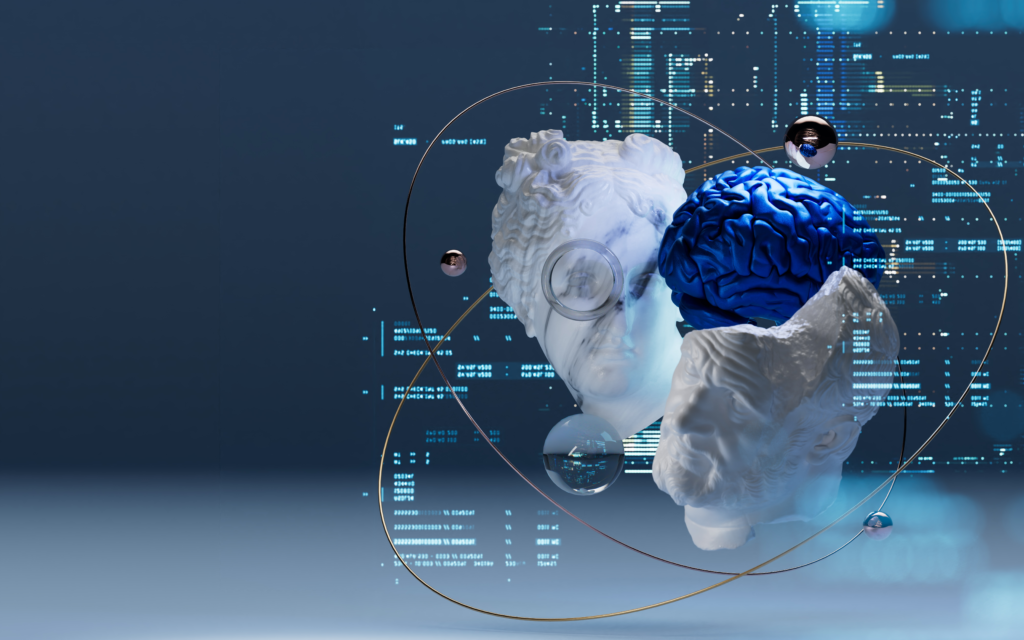AI vs. Generative AI: An In-Depth Comparison_2024
Introduction
Definition of AI
A subfield of computer science called artificial intelligence (AI) is devoted to building machines that can carry out operations that normally call for human intelligence. Learning, reasoning, problem-solving, perception, and language comprehension are some of these tasks.
Definition of Generative AI
A subclass of artificial intelligence called “generative AI” is concerned with using data already in existence to create new content—text, images, music, and even code. To create data that is comparable to the input data, it makes use of models like Variational Autoencoders (VAEs) and Generative Adversarial Networks (GANs).

Historical Context of AI
The phrase “artificial intelligence” was first used in 1956 at the Dartmouth Conference, and the area of artificial intelligence itself dates back to the middle of the 20th century. Early AI research emphasized problem-solving and symbolic approaches. Significant advancements in the discipline throughout the years have included the creation of machine learning, expert systems, and neural networks.
Historical Context of Generative AI
The field of generative AI is relatively new, having made major strides in the last ten years. An important turning point was Ian Goodfellow’s invention of GANs in 2014, which made it possible for AI systems to produce incredibly lifelike images. Since then, generative AI has developed quickly and had an impact on a variety of industries, such as entertainment, design, and the arts.
Importance of AI in Modern Technology
AI is now a crucial component of contemporary technology, fostering advancements across many industries. Through data analysis, it improves decision-making, automates tedious tasks, and offers insights. Applications for artificial intelligence (AI) span from sophisticated financial, healthcare, and autonomous driving systems to virtual assistants like Siri and Alexa.
Importance of Generative AI in Modern Technology
In the creative and design sectors, generative AI is essential. It makes it possible to produce fresh content, which can improve artistic expression, expedite the development of information, and even support scientific study by producing models and hypotheses. Applications such as game creation, music composition, and automated writing demonstrate its influence.
Core Concepts
Fundamental Concepts of AI
Artificial Intelligence (AI) comprises diverse methodologies and strategies, such as reinforcement learning, neural networks, and supervised and unsupervised learning. The goal is to develop systems that can learn from experience and adapt, emulating cognitive processes like perception, reasoning, and problem-solving.
Fundamental Concepts of Generative AI
Specifically, generating new data is the emphasis of generative AI. Important methods are VAEs, which create data using probabilistic models, and GANs, which combine a generator with a discriminator to produce realistic outputs. These techniques make it possible to produce original, high-quality content.
Key Differences Between AI and Generative AI
The main distinction between the two is that generative AI seeks to produce new content, whereas artificial intelligence (AI) seeks to carry out intelligence-intensive tasks. While generative AI is employed in content creation and design, predictive analytics, automation, and decision-making are all areas where AI is applied.
Similarities Between AI and Generative AI
Both AI and generative AI utilize machine learning and deep learning techniques. They rely on large datasets and advanced algorithms to learn patterns and make predictions or generate new content. Additionally, both fields contribute to advancing technology and innovation.
Methodologies
Machine Learning in AI
One of the main tenets of artificial intelligence is machine learning, which uses algorithms to let systems learn from and make judgments based on data. Regression, classification, clustering, and reinforcement learning are among the techniques, and each is appropriate for a certain kind of task.

Deep Learning in AI
Deep learning is a branch of machine learning that models complicated patterns in data by employing multi-layered neural networks, or deep neural networks. It has played a key role in the advancement of autonomous systems, natural language processing, and picture and audio recognition.
Neural Networks in AI
Inspired by the structure of the human brain, neural networks are made up of networked nodes, or neurons, that process information. They are essential to a lot of AI applications because they let the systems learn from the data and get better over time.
Machine Learning in Generative AI
In order to find patterns in data and produce new material, generative AI also depends on machine learning, namely unsupervised and semi-supervised learning. Preprocessing methods such as clustering and dimensionality reduction are used to data in preparation for generative models.
Deep Learning in Generative AI
For generative AI to work, deep learning techniques are essential. Deep learning models like GANs and VAEs are made to produce new data. The ability to create realistic photos, films, and audio has transformed the content development process thanks to these models.
Neural Networks in Generative AI
Generative AI models are based on neural networks. For example, GANs produce realistic outputs by using two neural networks in a competitive arrangement. These networks push the limits of creativity and innovation by learning to produce material that looks just like the input data.
Applications
AI in Healthcare
AI is revolutionizing healthcare through improved diagnostic precision, prognostic patient outcomes, and customized therapy regimens. AI-powered solutions can help with medication research, evaluate medical imaging, and track patients’ health in real time.
AI in Finance
Artificial intelligence (AI) is utilized in finance for fraud detection, risk management, algorithmic trading, and customized financial advising. Artificial intelligence (AI) systems examine market patterns, spot irregularities, and offer insights to support investors in making wise choices.
AI in Manufacturing
AI improves supply chain management, quality assurance, and predictive maintenance in industrial operations. It saves a lot of money by lowering downtime, raising operational effectiveness, and improving product quality.
AI in Transportation
AI is the driving force behind transportation advances, including traffic management systems and driverless cars. Self-driving cars can operate in challenging conditions thanks to AI algorithms, which also assist public transportation routes be optimized to ease traffic.
Generative AI in Art and Music
By producing original artwork and music, generative AI is transforming the art and music industries. AI models open up new possibilities for artistic expression by being able to produce sculptures, paintings, and musical compositions.

Generative AI in Content Creation
Text, photo, and video generation are all streamlined by generative AI. It saves time and boosts creativity by helping writers produce articles, marketers create commercials, and designers create pictures.
Generative AI in Healthcare
Generative AI aids in the discovery of new drugs, the construction of novel molecular structures, and the simulation of biological processes. It quickens research and development, which spurs more rapid advancements in medicines and treatments.
Generative AI in Design
By generating prototypes, improving designs, and producing customized user experiences, generative AI improves design processes. It pushes the limits of innovation and functionality in product design, architecture, and fashion.
Benefits
Benefits of AI in Everyday Life
Artificial intelligence (AI) makes life better by powering virtual assistants, improving e-commerce, and making tailored recommendations. It provides ease, enhances accessibility, and streamlines tasks.
Benefits of Generative AI in Creative Fields
Creative professionals are empowered by generative AI since it generates new ideas and automates monotonous activities. It increases the potential for design, music, and art while encouraging creativity and raising output.
Impact of AI on Business Efficiency
AI improves consumer interactions, automates procedures, and provides data-driven insights to increase corporate productivity. It enhances decision-making, lowers expenses, and boosts overall performance for enterprises.
Impact of Generative AI on Innovation
Innovation is fueled by generative AI, which produces original concepts, content, and solutions. It pushes the limits of what is feasible in numerous sectors, allows for quick prototyping, and investigates innovative concepts.
Challenges and Limitations
Ethical Considerations in AI
AI brings up moral questions about accountability, bias, and privacy. It is essential to ensure equitable and transparent AI systems in order to prevent discrimination and uphold public confidence.
Ethical Considerations in Generative AI
Because generative AI has the ability to produce malevolent content and deepfakes, it presents ethical challenges. To reduce these dangers, rules and regulations must be established.
Technical Challenges in AI Development
Technical difficulties in AI system development include algorithmic complexity, processing resources, and data quality. To overcome these obstacles, more research and creativity are needed.
Technical Challenges in Generative AI Development
Technical challenges for generative AI include guaranteeing the caliber and veracity of created material. Two important areas of focus include reducing biases in training data and enhancing model performance.
Limitations of AI
AI is not without its limits, such as its dependence on massive datasets, its inability to comprehend context, and its inability to handle circumstances that are unclear. The precision and dependability of AI systems may be affected by these constraints.
Limitations of Generative AI
The limitations of generative AI include its reliance on preexisting data and its propensity to generate biased or unrealistic results. To enhance generative models, training data must be both diverse and of high quality.
Latest Innovations
Recent Advances in AI
Recent developments in AI include improvements in computer vision, reinforcement learning, and natural language processing. Advances such as GPT-3 and AlphaFold are expanding the limits of artificial intelligence.
Recent Advances in Generative AI
Significant progress has been made in generative AI with models such as StyleGAN and DALL-E. These models can be used in entertainment, design, and the arts to produce incredibly lifelike representations.
Breakthroughs in AI Technology
Technological developments in AI, such those in quantum computing and neuromorphic engineering, have the potential to completely transform the industry. These technologies present fresh opportunities for the advancement and use of AI.
Breakthroughs in Generative AI Technology
Innovations in model architecture and training methodologies are driving the ongoing evolution of generative AI technology. These developments increase the potential of generative AI by enabling the creation of more varied and realistic material.
Future Prospects
Future Trends in AI
Upcoming developments in AI include the fusion of AI with IoT, the emergence of explainable AI, and the progress made in autonomous systems. AI will keep changing businesses and enhancing people’s lives.
Future Trends in Generative AI
Virtual reality, personalized content creation, and the creative sectors will all witness a rise in the use of generative AI. Reducing biases and improving model accuracy will be the main goals of future advancements.
Potential of AI in Emerging Markets
With its potential to improve healthcare, education, and agriculture, artificial intelligence holds great promise in emerging markets. It can stimulate economic expansion and raise living standards in emerging nations.
Potential of Generative AI in Emerging Markets
By fostering the creation of local content, encouraging artistic expression, and assisting in the creation of new goods and services, generative AI can foster innovation in developing markets.
Comparative Analysis
Comparing AI and Generative AI: A Side-by-Side View
While generative AI and AI have different uses, they both use similar methods. While AI is primarily concerned with carrying out intelligent tasks, generative AI is committed to producing original content. Together, these domains strengthen technological skills overall.
Strengths and Weaknesses of AI
Predictive analytics, automation, and data-driven decision-making are some of AI’s strong points. It does, however, encounter difficulties including data dependency and moral dilemmas.

Strengths and Weaknesses of Generative AI
While generative AI is great at creating creative and engaging material, it has trouble maintaining authenticity and avoiding prejudices. The success of innovation depends on striking a balance between ethical issues and innovation.
Choosing Between AI and Generative AI for Different Applications
Depending on the application, generative AI or AI is the better option. While generative AI is best used for creative and design-focused initiatives, artificial intelligence (AI) is best suited for jobs requiring intelligence and decision-making.
Conclusion
Summary of Key Points
Technology is advanced by two separate but related fields: artificial intelligence (AI) and generative AI. Intelligent task performance is the main goal of AI, whereas generative AI is more focused on content generation.
The Future of AI and Generative AI
There is a lot of promise for the future of generative AI and artificial intelligence, and both areas should continue to progress. Advances will increase the creative potential of generative AI and further incorporate AI into daily life.
Call to Action for Further Education
To stay ahead in the rapidly evolving world of AI and generative AI, continuous learning and adaptation are essential. Explore educational resources, participate in professional communities, and stay informed about the latest developments to harness the full potential of these transformative technologies.







